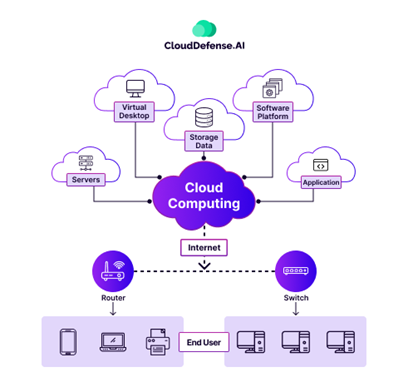
To deeply and accurately understand the scope of cloud computing, we need to acknowledge its roots and history. Robert Licklider, the director of the US Department of Defence’s ARPA, is known as the father of Cloud Computing. Dr. Licklider is known to have introduced the first signs of cloud computing during his directorship in the form of ARPANET, showing that computers could be used as a medium of communication as well. However, it was not until 2002 that a modern, more scalable cloud computing format emerged when Amazon released Amazon Web Services, widely known as AWS.

Cloud computing, in very basic and simple terms, refers to the delivery of on-demand computing services. This refers to the provision of all Internet-based services, such as access to software, storage, servers, and various other Internet products and services. Cloud computing allows small-scale individual users to have access to large-scale services by paying as they go and renting. Cloud computing is currently being utilised by nearly all industries worldwide for various purposes. The healthcare sector utilizes it to provide personalized treatments to its patients, whereas video game companies use the cloud to enable their games to reach players across the Internet.
Present Scope
Before delving into the future of cloud computing, it is rather imperative for us to understand the present scope of cloud computing. As mentioned earlier, it is the provision of digital products and services for small-scale users to access functions such as computing, storage, access to software, and other products. To classify, the following are the three most utilised services in the domain of cloud computing

- Infrastructure as a Service (IaaS): Infrastructure as a Service, or IaaS, allows the provision of networking, computers (physical hardware), and server access to businesses and enterprises on demand. This is the most flexible of all cloud computing products and services. IaaS works by digitising the infrastructure required for computing and managing data. It provides the users (enterprises and small-scale users alike) with access to storage services (like OneDrive), servers, and networking, all online. This eliminates the requirement for each enterprise and user to have a database for storage and a data centre for server management.
- Platform as a Service (PaaS): Primarily used by developers, PaaS enables them to build, deploy, and manage software and applications without having to directly handle underlying digital infrastructure. Infrastructure like data centres and server management is, in a sense, outsourced. This enables developers to concentrate fully on building the platform and application, thereby removing the burden of managing infrastructure. PaaS also has provisions for tools and services for development that ease the process of developing and reduce the time spent in coding and accessing better, more advanced tools.
- Software as a Service (SaaS): In simple terms, SaaS allows users to access software via the cloud from practically anywhere and everywhere. It’s designed to be highly user-friendly and extremely accessible. Furthermore, SaaS operates on a subscription basis and permits users to cancel or avail themselves of the service according to their convenience. This gives a lot of flexibility to the customer while using the service. For the provider, SaaS is a highly cost-efficient and scalable medium of providing their services. Since the services can be accessed from anywhere, it makes commercial aspects like business management and collaboration easy and effective.
Future Scope
There is nothing more widely used on the Internet today as much as AI, especially GenAI or Generative Artificial Intelligence. Furthermore, 2025 is the first year in which GenAI has been included as a cloud service open to the public. Given the advent of AI in almost all walks of life, it was not long before it was adapted and utilised as a part of cloud services. At the moment, cloud platforms and services utilise AI heavily in terms of providing advanced analytics, machine learning, computing, video editing and generation, and a multitude of other services.

As we proceed into an era powered by digital tools, enterprises will be modeled and depend on simplified management provided by sophisticated cloud platforms. Cloud computing offers near-seamless integration of software and business, a structure that is only bound to grow further with the integration of AI into it.
Furthermore, accessing features like Quantum Computing and serverless computing will become more accessible and even cost-effective as the industry expands and grows in the coming years. This would not only allow small-scale and medium-scale enterprises but even individual users to complete complex computing tasks in short spans of time. And this is just the tip of the iceberg in the world of cloud computing. Considering the vast range of its applications, cloud computing still has immense potential for growth and expansion.

Conclusion
In conclusion, this blog effectively traces the evolution of cloud computing, from Robert Licklider’s foundational work with ARPANET to the commercialisation of cloud services through the launch of Amazon Web Services in 2002.
It delineates the primary service models—Infrastructure as a Service, Platform as a Service, and Software as a Service—each of which plays a pivotal role in transforming how users and enterprises access digital resources. These models facilitate scalable, cost-efficient, and user-centred solutions across diverse sectors, including healthcare and digital entertainment.
Looking to the future, the integration of generative artificial intelligence, serverless architectures, and quantum computing signals a transformative shift in the scope and capability of cloud services. As these technologies become increasingly accessible and economically viable, they will enable users at all levels to undertake complex computing tasks with greater agility and precision. The analysis thus affirms that cloud computing is not only firmly established but is on a trajectory of significant and sustained expansion.
Written by – Sanskaar Shetty
Edited by- Anjali Khimasiya
The post Cloud Computing: The Invisible Engine of the Digital Economy appeared first on The Economic Transcript.






